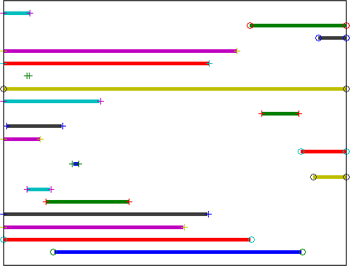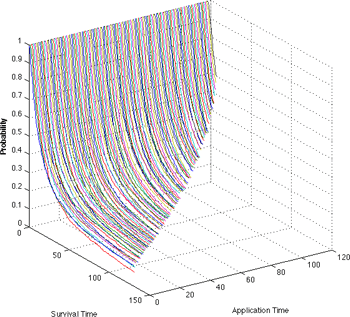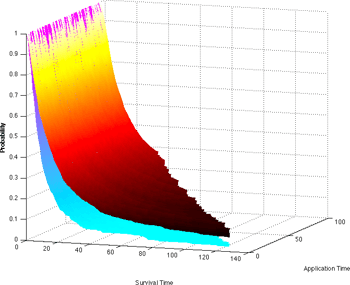Teaming Up for Change
Elizabeth Rasch is part of a multidisciplinary team developing innovative measures of disability using computer adaptive testing.

Rasch and colleagues at a bi-monthly team meeting. (From l to r: Elizabeth Rasch, Leighton Chan, Minh Huynh, Diane Brandt, John Collins)
When Elizabeth Rasch, P.T., Ph.D., shook hands with a representative from the United States Social Security Administration (SSA) in 2007, she assured him that the process for assessing individuals seeking disability benefits could be improved. Little did she know that her confidence would win over $10 million in outside funding for the NIH Clinical Center’s Rehabilitation Medicine Department to develop a portfolio of cutting-edge disability measurement tools and systematic analytic approaches to inform SSA’s decision making processes. With Dr. Leighton Chan, Principal Investigator, at the helm, Rasch’s bold statement set in motion the evolution of a talented multidisciplinary team capable of taking on the enormous challenge.

Time course of events for participants, depicting entry, withdrawal due to death, or survival (right censoring)
Computerized adaptive tests (CATs), much like those used to test subject knowledge in academic settings, are now set to revolutionize how the SSA approaches disability applications. Compared to static tests with a fixed number of items, CATs maximize exam accuracy by successively presenting questions based on answers from previous questions. For example, if an examinee performs well on an item of intermediate difficulty, he or she will then see a more difficult question. Or, if someone performs poorly on a question, the next one would be simpler.

A “survival surface” depicting the probability of survival over time accounting for application time
“The advantage of using CATs to evaluate individual capabilities is that the test self-levels based on the answers received,” Rasch explains. “So, when we’re testing for mobility, users who stated that they can only walk with a cane or crutches won’t be asked questions about how far they can run. The diminished redundancy makes this a far more efficient tool.” The CATs are being developed in partnership with the Boston University Health and Disability Research Institute and will include a number of assessment domains such as mobility, interpersonal interactions, and applied cognition.

Rasch and colleagues discuss findings from the SSA Compassionate Allowances project. (From l to r: Elizabeth Rasch, Leighton Chan, Meghan Gleason, John Collins, Minh Huynh)
In addition to making the evaluation tools more efficient, Rasch and her colleagues framed their approach using contemporary tools, such as the World Health Organization (WHO) International Classification of Functioning, Disability, and Health. In this context, work disability is viewed as the outcome of the interaction of individual capabilities relative to workplace demands. The ability to work is driven not only by what individuals can do, but the requirements placed upon them by particular jobs. “The current mobility assessment questions were written 50 years ago, when many more people had jobs in manufacturing,” Rasch says. “Questions on physical abilities are no longer as applicable as they once were, whereas questions on the cognitive abilities to operate a computer program, for instance, are far more relevant for today’s workforce. ”Similarly, there has been a shift in the type of disabilities being reported by applicants, from physical injuries such as loss of limbs in the 1950s, to mental health and musculoskeletal problems in 2012.

Aaron Heuser describes the mathematical basis for a computational model
The overall scope of the project is huge, with new CATs needed for both healthcare professionals and patient self-reporting, all of which must match the new standards defining the types of jobs in which people now work. Rasch estimates the overall development time for the new CATs will be on the order of eight years, but she isn’t fazed by the enormity of the project. Supported by a team of physicians, physical therapists, health policy experts, health service researchers, economists, mathematicians, engineers, and computer science specialists, Rasch takes great pride in the accomplishments of her colleagues. “It’s a privilege to be part of such a diverse group, developing new models for the health services and simultaneously changing the field as we know it,” she says.

Two “survival surfaces” depict differences in the probability of survival between two groups of individuals: those with reference conditions and those with a comparison condition
In addition to CAT development, Rasch and her team are working on an important supporting project—developing systematic, data-driven analytical approaches, using SSA’s own administrative data, to inform SSA’s decision making processes regarding disability evaluation. One sub-project involves augmenting the list of diseases designated for Compassionate Allowances—a program that helps the SSA quickly identify and provide benefits to severely disabled individuals, as defined by predetermined objective medical criteria. The SSA receives over three million applications each year, but individuals with diseases like cancer and neurodegenerative illnesses often do not have time to wait for adjudication. Rasch and her team quickly started establishing mortality profiles for recognized Compassionate Allowances diseases, numbering 88 in 2010, and then created a “survival surface”—a three-dimensional curve enabling researchers to identify diseases with a similar rate of mortality. Thanks to those efforts, the number of conditions immediately eligible for disability benefits has expanded to 113, and it will likely further increase to 200 conditions by the end of 2012.

“It’s pretty incredible to be working in a field where the work we’re doing today can literally lead to changes in the legislation tomorrow,” Rasch says. “That’s a strong driving factor me—knowing that I’m part of a team that’s really helping to drive change.”
Elizabeth K. Rasch, P.T., Ph.D., is a Staff Scientist and Chief of the Epidemiology and Biostatistics Section of the NIH Clinical Center Rehabilitation Medicine Department.
This page was last updated on Wednesday, May 24, 2023